
Editor/s note: Note the contrast with the adjacent article (dated Ocxt 7, 2023) on Israeli environmental localism.
In an exclusive interview with Al Arabiya English, Richard Bush, NEOM’s chief environmental officer, says the mega project will demonstrate to the world what is possible in the realms of sustainability.
Jennifer Bell, Al Arabiya English. 27 October ,2023
Saudi Arabia’s NEOM will be a global blueprint for going green and will put the Kingdom on the map for turning the vision of sustainable living into a reality, the chief environment officer at the futuristic $500 billion mega business and tourism project, Richard Bush, told Al Arabiya English in an exclusive interview.
NEOM encompasses vertical city THE LINE, business hub Oxagon, luxury yachting destination Sindalah and the mountain resort of Trojena, which will all be powered entirely by renewable, clean energy.
Bush, who oversees the sustainability elements of the Kingdom’s mega project, said NEOM will demonstrate to the world “remarkable frontiers for the future of humanity” and what is possible in the realm of sustainability.
“The area where NEOM is being developed is the perfect place to turn the vision of sustainable living into a reality,” he said.
“Firstly, it’s a greenfield site, enabling us to build the infrastructure that we need as opposed to being encumbered by existing assets and to use the most optimal sustainable construction materials. Secondly, NEOM’s location is perfectly optimized to create clean energy from wind and solar,” he said.
A living laboratory
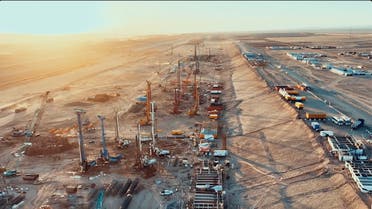
NEOM, one of the world’s most ambitious sustainable urban developments, planned by Saudi Arabia’s Crown Prince Mohammed bin Salman, is being built on a vast greenfield site with multiple benefits as it allows developers to build from the ground up as a living laboratory, said Bush. As it has no legacy infrastructure, it will allow NEOM to advance energy, water, and hydrogen innovation while providing sustainable fuels such as green hydrogen to international users.
“A greenfield site enables us to design the various urban environments within NEOM in a way that fully integrates and optimizes sustainable solutions,” he said. “This includes leveraging the advantages of height in order to conserve nature (as seen in The LINE), choosing optimal materials for construction, and designing urban environments in a way that optimizes integration, thereby allowing for huge efficiencies in energy and water use.”
This greenfield site is also the first to produce green hydrogen at scale, paving the way for the hydrogen economy globally due to the abundance of solar, wind and water resources here. This is because of NEOM’s advantageous location near the Red Sea.
“The region of NEOM enables us to aim for a future reliant on renewable energy,” he said. “It has an abundance of sun and wind, which will not only provide sustainable energy on their own but also offer a singular set of conditions for developing new clean technologies, such as green hydrogen. As such, NEOM will grow to be the world’s first large-scale renewable energy system,” Bush explained.
NEOM’s aim is to become a global hub to produce green hydrogen and a center for research and innovation in this field. “We are already building the world’s largest green hydrogen project at NEOM,” Bush said, adding that the energy journey at NEOM is a bringing together of the potential of natural resources and the power of new technology.
A reference point for global change
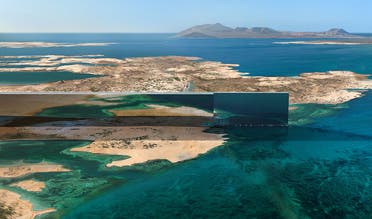
NEOM aims not only to be the future of sustainable living but also to serve as a reference point for global cities to become greener, said Bush.
“Through the creation of NEOM, we are exploring how to address global problems such as climate change (including decarbonization of the construction process) and urban sprawl. These solutions will span all development phases of NEOM – design, construction and operational mode.”
Currently, he said, there is rapid urbanization around the globe, particularly within harsh climatic conditions such as the ones prevailing in India and Africa.
“The solutions that NEOM pioneers can be deployed across hundreds of other urban, industrial and natural environments, acting as a blueprint for these countries and the challenges they are facing,” said Bush.
NEOM also aims to serve as a guiding tool on ways to drive down carbon emissions, said Bush.
“While I commend the aspiration to achieve net-zero emissions, globally, there has been an unexpected result of this – which is carbon offsetting,” he told Al Arabiya English. “In my opinion, offsetting alone isn’t enough. Instead, we should be looking at reducing the amount of carbon emissions we produce.”
Carbon reduction involves investing in technology and concepts that drive down carbon emissions, which is “exactly what NEOM is doing,” said Bush.
NEOM aims to operate on 100 percent renewable energy, resulting in an incredibly low carbon footprint. Additionally, it wants to operate a circular economy, decarbonize the supply chain to minimize embodied carbon and drive down real emissions.
Bush said while the “rest of the world is currently focused on carbon emissions through energy systems,” a crucial element that is key to driving down carbon emissions is often overlooked and that is the impact of embodied carbon –the carbon that is created during the construction of materials.
“Embodied carbon is the frontier where the climate change challenge is going to be won or lost,” Bush said. As a case in point, carbon emissions account for 7 percent of our carbon footprint. Hence, 93 percent of our carbon footprint will be associated with the materials used to build the region, he added.
“At NEOM, we are doing everything we can to reduce embodied carbon and we then need to share our knowledge so that other constructions across the world can benefit from our thinking, experience, and technology,” he said.
Utilizing technology for green goals

According to Bush, advancements in technology are enabling humanity to build sustainable settlements in traditionally challenging environments, such as Saudi Arabia’s desert regions.
“Technological advancements mean that locations that were traditionally challenging to build in – areas of heat and limited water – are becoming viable options,” he explained. “More than that, these options have the ability to become remarkable frontiers for the future of humanity.”
To cite an example, Bush mentioned transformations in desalination techniques to ensure a water supply that does not necessitate groundwater extraction. “Our advanced water management techniques will also positively impact other sectors,” he added.
For instance, 100 percent of wastewater will be recycled and harvested for cellulose, nutrients, grit, and biogas, which are used in landscaping, agriculture, energy, and construction.
Also, seasonal stormwater runoff will be retained and allowed to return to the land through the development of wetlands and other retention methods.
“People have been living here in the NEOM region for millennia,” said Bush. “However, technological developments enable us now to create urban dwellings that offer more comfort, minimized energy usage and reduced impact on the environment. Due to population growth and climate change, we must learn to make better use of space and resources.”
A blueprint for sustainability
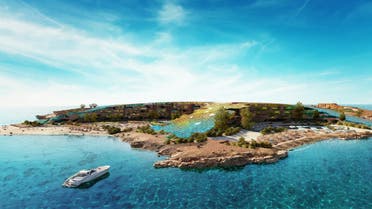
It is the first destination to open with Saudi Arabia’s $500 billion mega project NEOM, and the planners behind the luxury island Sindalah have given a preview of the mega development as it gears for its 2024 opening. (NEOM)
NEOM’s investment in technology will also support global action, said Bush.
“NEOM’s investment in technological innovation is integral to achieving NEOM’s sustainability goals. Through our investment in technology, we know we will open the doors for global adoption of such technology,” he further said.
“For example, there is a proven technology that exists around the world. NEOM is taking this proven technology and making it operational at scale. Once it’s made that leap into scalability, that’s when global adoption can take place. We will create a virtuous cycle of triggering demand, enabling companies to invest in their transition for a better environmental future and global adoption.”
NEOM engineers are already testing a differentiated Cognitive Environmental Compliance Management (CECM) tool powered by state-of-the-art technology such as satellites, autonomous drones, and OBD/GPS tracking.
“The tool addresses the limitations of traditional compliance methods and ensures we are upholding our high level of environmental regulation across the entire region,” said Bush.
Another prime example of scalable, sustainable technology is green hydrogen, through which NEOM will address its energy needs with the least impact on the environment.
Green energy

At the center of that plan is the $8.4 billion green hydrogen production plant, which will put the Kingdom on the global map for clean energy transition, David Edmondson, CEO of the NEOM Green Hydrogen Company (NGHC), told Al Arabiya English earlier this year.
Construction is progressing on the site – based in NEOM’S OXAGON – and remains on track for full-time operations by the end of 2026.
Once complete, this joint venture between Acwa Power, Air Products and NEOM will be the world’s largest green hydrogen production facility – stretching over 300 square kilometers of land, in which around 5.6 million solar panels will produce up to 2.2GW of solar energy. When operational, it promises a staggering output of carbon-free hydrogen.
Bush said: “It will integrate up to 4GW of solar and wind energy to produce up to 600 tonnes per day of carbon-free hydrogen by the end of 2026, in the form of green ammonia, as a cost-effective solution for the transportation and industrial sectors globally.”
NEOM aims to ensure that 80 percent of all green hydrogen produced locally is available for global export in the future.
NEOM’s energy policy has two key strands: Firstly, reducing the amount of energy consumed. Secondly, ensuring that the energy consumed comes from 100% renewable sources.
With regard to minimizing energy, activities include making sure the built environment is designed and constructed to minimize energy usage.
“For example, through the design of the urban environments, we will optimize passive energy – relying on passive airflow for cooling, instead of utilizing water for air-conditioning,” explained Bush. “Additionally, a high level of integration will allow for huge efficiencies in energy and water use, drastically reducing pollution,” he said, adding that an integrated Digital Energy Platform will be introduced in NEOM that will form the backbone of its clean energy system. Also, bulk energy supply (including flexibility measures to balance the system) will power NEOM industries and businesses, optimized for record low costs, minimal emissions, and maximum reliability.
In terms of operating on renewable energy, NEOM seeks to be the world’s first large-scale 100 percent renewable energy system by 2030, harnessing NEOM’s unique wind and solar profile.
“With regard to water, specifically, NEOM aims to minimize costs, eradicate waste, and prevent pollution,” said Bush.
“This means recycling 100 percent of wastewater, having a net zero footprint, and using renewable energy and sea-water mining. Clean energy will be powering the process of desalination. The technique for desalination with zero liquid discharge, ENOWA, will generate valuable waste products that can be used to provide sustainable solutions worldwide and offset production costs.”
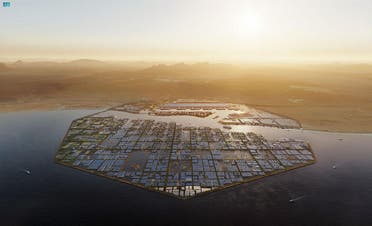
Given the scale of NEOM, Saudi Arabia will also have a significant influence on global supply chains, said Bush.
“We are therefore seeking to necessitate a change in global supply chains so that sustainable materials are created on a commercially viable scale for hundreds of thousands of other construction development projects. We want to lower the price of sustainable materials so that they are commercially viable for all.”
“For example, we are working with a range of cement companies that are developing new knowledge of and technologies for green cement – i.e., low-carbon cement. Additionally, we’re working with our steel manufacturers to drive forward the technologies for developing and utilizing green steel.”
A benchmark for the circular carbon economy
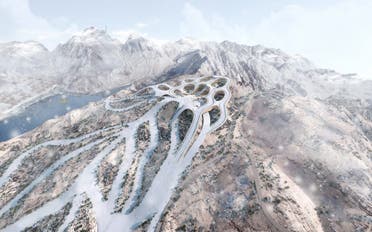
NEOM will also subscribe to a circular carbon economy – a framework for managing and reducing any carbon emission from renewable energy. It is a closed-loop system involving the 4Rs: Reduce, reuse, recycle, and remove.
“NEOM is integrating circular economy principles into all aspects of construction and operation. For example, in NEOM’s advanced and clean industrial city (OXAGON), we will maximize the synergies of various industries, helping manufacturers close the loop on waste,” explained Bush.
Developing a circular economy is integral to NEOM’s vision to redefine livability, business and conservation, said Bush.
“Every year, the lowest performers in waste recovery are sending an average of 93 percent of waste to landfill. This is a huge mismanagement of resources. Thus, NEOM is pioneering the principles of a circular economy to address this and show the way forward,” Bush added.
Illustrating the point further, he said: “Right now, our biggest contribution to the circular economy is through the materials we are using to build NEOM: 90 percent of our raw input required for the foundations of the various urban environments being constructed comes from NEOM’s demolition waste.”
NEOM also has a clear-cut decarbonization strategy.
“One of the key problems we’ve been exploring is how to decarbonize the construction of new urban environments – how to abate what’s called ‘embodied carbon’. Embodied carbon is an issue that is often dismissed, but it represents an average of 50 percent of the total whole-life carbon emissions of new building projects,” he explained.
Bush said regulation and policy are important in order to put NEOM’s ambitions into practice.
“With the private sector being driven by profitability, policy and regulation are the main and most reliable instruments in driving big environmental outcomes,” he said. “We, at NEOM, are leading the global perspective and working with international leaders around policies and regulations that will drive the overall progress of our planet. This is why our policies tend to be heavily based on the incentivization of people to take the pathway of environmental progress as much of the collective outcome starts with an individual effort,” he said.
“This includes regulation around carbon emissions and supply chain performance. This is best done through the intertwining connection of management, policy, regulation, and culture. This connection can start driving human behavior, which helps us build a culture and awareness around sustainability on a personal level.”
Sustainability in action

NEOM will also prioritize environmental conservation and regenerative development in its creative processes – focusing on restoration, repair, and rewilding to lead the renaissance of Arabian wildlife.
Furthermore, nature reserves will safeguard flora, fauna, corals and wadis.
As part of its sustainability mission, NEOM has also launched its very own regreening initiative in collaboration with the National Center for Vegetation Cover and Combating Desertification.
As part of its program to rehabilitate at least 1.5 million hectares of land, NEOM’s initiative will see the return of 100 million native trees, shrubs and grasses by 2030 to aid the restoration of degraded land and repair of wildlife habitats.
That goal will see NEOM plant 16 million trees within the next 12 months.
As a point of comparison, Bush mentioned Australia’s goal to plant one million trees in a decade.
NEOM’s initiative aims to support Saudi Vision 2030, the Saudi Green Initiative and the Middle East Green Initiative, launched by the Saudi Crown Prince, focusing on protecting and sustaining the vegetation cover, rehabilitating degraded sites, and achieving sustainable management in pastures and national parks.
Unique green initiatives in key regions
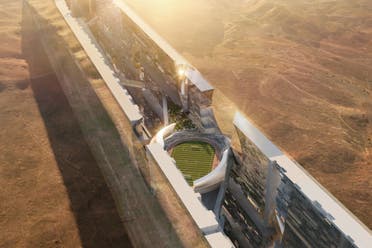
While NEOM aims to have sustainability at its core across its 26,500-square-kilometer site, each of the four key regions at the vast site has crucial, unique green elements.
For example, Saudi Arabia’s revolutionary THE LINE project – a 170-kilometer-long city to eventually house up to nine million people – aims to be free of cars, have zero carbon emissions, be powered entirely on clean energy, and be run by artificial intelligence. Modern construction methods, using a pioneering ‘kit of parts,’ mean THE LINE can be constructed faster, safer, more efficiently, more sustainably, and at a consistently higher quality than conventional builds, Executive Director of THE LINE, Giles Pendleton, told Al Arabiya English earlier this year.
Meanwhile, luxury island Sindalah – spanning more than 84 hectares of land and aiming to attract 2,400 visitors a day by 2028 – follows NEOM’s vision and purpose: Adapting to and mitigating the impact of climate change and unchecked development while promoting new ways of preventing environmental degradation and regenerating nature.
Snow resort Trojena will also be powered entirely by renewable energy and will be built to the highest sustainable standards. In line with NEOM’s broader commitment to conservation, just 57 square kilometers of Trojena’s 1,400-plus square kilometers of total land area will be developed – which represents around five percent of the total area of the mountain resort. Approximately 75 percent of the slopes will be covered with machine-made snow, created in the most sustainable way possible by using only water and air as ingredients, Executive Director of Trojena, Philip Gullett, told Al Arabiya English earlier this year.
OXAGON, touted to be the “world’s largest floating structure,” which will be the business and industrial arm of NEOM, also represents a radical new model for future manufacturing centers. The unique octagonal design minimizes impact on the environment and provides optimal land usage, with the remainder open to preserve 95 percent of the natural environment. A defining feature of the city is the world’s largest floating structure, which will become a center for NEOM’s Blue Economy and achieve sustainable growth.
Explaining NEOM’s commitment to total clarity on the environmental impact of its activities, Bush cited its technology-driven environmental compliance tool called ‘Cognitive Environmental Compliance Management (CECM)’ which will substantially increase compliance monitoring ability and tracking of environmental data. “This will enable us to hold ourselves accountable and push us to drive ongoing innovation and transformation,” Bush said.
“We care deeply about our environmental performance. That is why we are bringing environmental management into the 21st century that is technology-reliant, further boosting our capacity to detect, manage, monitor, and improve the environment.”
